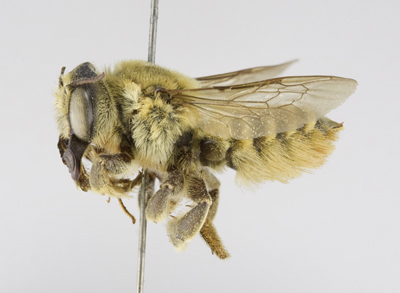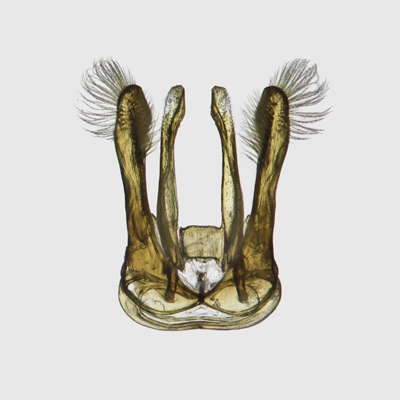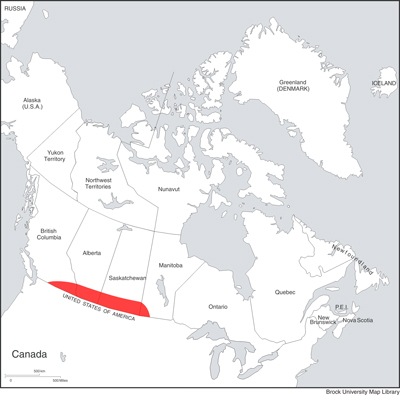
33. Megachile (Xanthosarus) fortis Cresson, 1872
Megachile fortis Female |
Megachile fortis Male |
Megachile fortis Cresson, 1872. Trans. Amer. Entomol. Soc. 4: 262 (♂).
Megachile emoryi Cockerell, 1904. Entomologist 37: 7 (♀).
Megachile fortis var. vestali Cockerell, 1913. Ann. Mag. Nat. Hist. (8) 11: 530 (♂).
Diagnosis.The female of M. fortis can be recognized by the combination of 5-dentate mandibles, with the 4th tooth approximately parallel-sided throughout its length, with an oblique emargination between 3rd and 4th teeth which is much deeper than emargination between 2nd and 3rd teeth, the width of emargination between the 3rd and 4th teeth broadly semi-circular in shape, the apical border of S6 being thickened and weakly upcurved, extending slightly beyond the apical tergum. They are most similar to M. dentitarsus, M. latimanus and M. perihirta. Females of these species have the width of emargination between 3rd and 4th teeth subequal or at most twice as wide as the 4th tooth at midlength, the emargination tapering and angled towards inner mandibular edge, and S6 with apical border not thickened or upcurved, not extending beyond apical margin of T6. The male of M. fortis is distinct from all other Megachile by the truncate, basal mandibular tooth. In addition, and like males of the subgenus Megachiloides, the postmedian transverse carina on T6 is rounded or obtusely angulate medially (not deeply emarginate as in other Xanthosarus).
FEMALE: Length 16-18 mm.
Head:
Figure M33: Megachile fortis female mandible |
1) compound eyes parallel; lateral ocelli nearer eyes than margin of vertex (4:5), 2) apical rim of clypeus shiny and impunctate, slightly incurved medially, with a few minute crenulations laterally, 3) mandibles 5-dentate, width of emargination between 3rd and 4th teeth about three times as great as the width of the 4th tooth at midlength, shallow but distinct emargination between 4th and 5th teeth, with complete cutting edges between 3rd and 4th and 4th and 5th teeth, and an incomplete one between the 2nd and 3rd teeth (Figure M33), 4) gena subequal to compound eye in width, 5) vertex and gena very finely and closely punctate throughout, frons rather finely and closely punctate, the supraclypeal area more densely rugose, clypeus finely and densely punctate along upper margin with an incomplete median impunctate line basally, but punctures becoming more coarse, deep and distinct and at least slightly separated toward apical margin, 6) pubescence of head entirely pale yellowish, rather short and quite dense around antennae and paraocular area, more whitish and elongate on gena below, becoming sparse and more yellowish above, that on vertex rather short but erect, 7) F1 longer than broad (3:2), longer than pedicel, subequal in length to remaining flagellomeres, apical flagellomere more elongate (5.5:2).
Mesosoma:
1) pubescence entirely pale, pleura and posterior face of propodeum with quite dense, rather short, pale yellowish pubescence, that on dorsal surface somewhat brighter yellow, rather short but copious, partially decumbent medially on mesoscutum, 2) surface very dull, uniformly very densely and finely rugosopunctate, propodeum somewhat more shining laterally, with minute, shallow, close and vague punctures, triangle dull and impunctate, 3) basitarsi only slightly shorter than their tibiae, mid and hind basitarsi nearly as broad as their tibiae, spurs yellowish-brown, 4) tegula somewhat shining, with exceedingly minute and very close punctures, pubescent anteriorly, 5) wings subhyaline, very faintly clouded apically, veins black.
Metasoma:
1) T2 and T3 quite deeply grooved across base, basal margin of groove quite distinctly carinate, T4 shallowly depressed across base but hardly grooved, T5 hardly depressed across base and without a definite, basal, carina-like margin, apical margins of T1-T5 somewhat depressed, yellowish-hyaline, densely fringed with short, yellowish pubescence forming conspicuous, transverse and entire fasciae; discal pubescence of T1 copious, elongate, pale yellow, that on T2 somewhat shorter, and very short and less conspicuous on T3-T5; punctures very fine and quite densely crowded, uniform on the more basal terga, becoming slightly coarser toward apical margin of T5, T6 nearly straight in profile, with only a very few, short, erect hairs toward the base, T6 with punctures across base very fine, densely crowded but rather distinct, becoming indistinct apically, apical half covered with yellowish, appressed hairs that obscure the surface, 2) S6 rather uniformly covered with pale, rather short, scopal hairs, apically with a rather prominent, thickened margin that is bare, weakly up curved and extending a little beyond the apical tergum, scopa otherwise pale yellow; sternal plates closely punctate.
MALE: Length 14-15 mm.
Head:
1) compound eyes parallel; lateral ocelli considerably nearer eyes than margin of vertex (7:5), 2) clypeal margin nearly straight beneath dense pubescence, with a small, median shiny protuberance, 3) mandibles 3-dentate, lower process extremely broad, truncate, basal in position, 4) gena subequal to compound eye in width, slightly excavated below, this area fringed with dense, yellowish, rather short hairs, 5) vertex and gena quite uniformly, finely and densely punctate, lower portions of face in large part very finely and closely punctate beneath dense pubescence that completely hides surface, 6) pubescence of face and vertex yellowish, dense below level of antennae, rather elongate on vertex medially, becoming shorter, more inconspicuous laterally, very sparse and short on gena, becoming somewhat paler and more dense along lower margin, 7) F1 about as long as broad, almost twice as long as pedicel, and shorter than remaining flagellomeres, which are longer than broad (2:1.5), apical flagellomere very broadly dilated.
Mesosoma:
1) pubescence rather dense, not very elongate, pale yellowish on pleura and propodeum, somewhat deeper yellow and rather short and erect but not hiding dorsal surface, 2) mesoscutum and scutellum dull, with very fine, densely crowded punctures, those on pleura minute and densely crowded, propodeum somewhat more shining, with close but rather vague and indistinct punctures, triangle dull and impunctate, 3) front coxal spine robust, rather acutely pointed apically, broad at base, with a large transverse patch of suberect, reddish-brown bristles at base, coxa otherwise largely bare; front tarsus pale yellow, rather broadly dilated, about equal to tibia, but anterior margin only very obscurely or shallowly excavated, posterior fringe dense, about equal in length to breadth of each tarsomere, whitish toward apical tarsomere, more yellowish-brown at base, outer face of front tibia black, with apical margin yellowish, other two faces more reddish-brown, and posterior face of front femur black, with lower margin carinate and yellowish, other faces largely yellowish-brown, densely fringed posteriorly with yellowish hairs that are elongate toward base; mid tibial spurs well developed; middle basitarsus slightly narrower, considerably shorter than tibia, with a much elongated, yellowish, posterior fringe; hind femur somewhat swollen, hind basitarsus about half the length of its tibia, 4) tegula very minutely and closely punctate, anterior part quite densely pubescent, 5) wings subhyaline, very faintly clouded apically, veins black.
Metasoma:
1) T2 and T3 quite deeply depressed at base, T4 and T5 more shallowly so, basal margin of depressions distinct, carinate, apical margins of terga uniformly, rather deeply depressed, very deeply so on T4 and T5, the discs overhanging the depressed rims, with dense, entire, yellowish, apical fasciae on T2-T5; T1 with copious, elongate, yellowish pubescence, apical fringe rather obscure, discal pubescence of T2-T5 erect, conspicuous, entirely pale, but not obscuring the fasciae, T5 more or less bare apically, punctures very fine and close throughout, minute on the more basal terga, becoming somewhat more irregular on T5 apically, T6 rather densely tomentose, very closely and finely punctate beneath the pubescence, with a slight median ridge, and slightly depressed on each side, the carina slightly down curved and truncate, with no median emargination, median apical teeth broadly carinate, much nearer the very small lateral angles than to each other; T7 angulate medially, 2) S1-S4 very finely, uniformly and closely punctate, discal surfaces sparsely pubescent, apical margins of S1-S3 depressed, yellowish-hyaline, quite densely fasciate, the fasciae much broader laterally, S4 not conspicuously fringed but with a quite distinct, median, carinate and acute tubercle.
Genitalia: Figure G33.
|
Figure G33: Megachile fortis genitalia |
Discussion:
This is our largest indigenous Megachile, and one of the most uncommon in Canada. Megachile fortis is considered to be a specialist of Helianthus and nests in the ground (Neff and Simpson 1991) (Table 1). Fischer (1956) gave an account of the morphology and reproductive mechanisms of the male.
Distribution:
Southern MB-BC (see Map 33).
|
Map 33: Canadian distribution of Megachile fortis |




